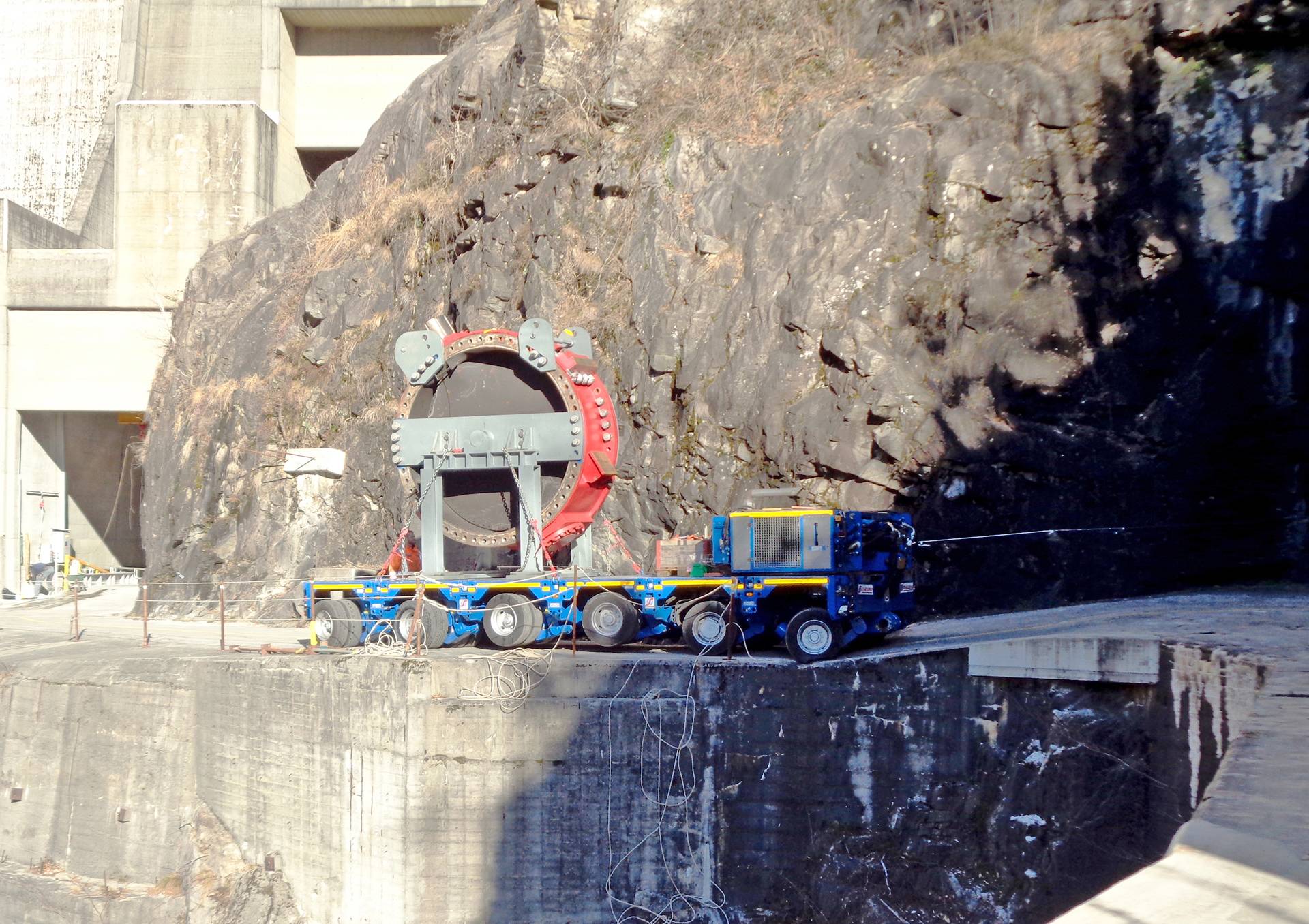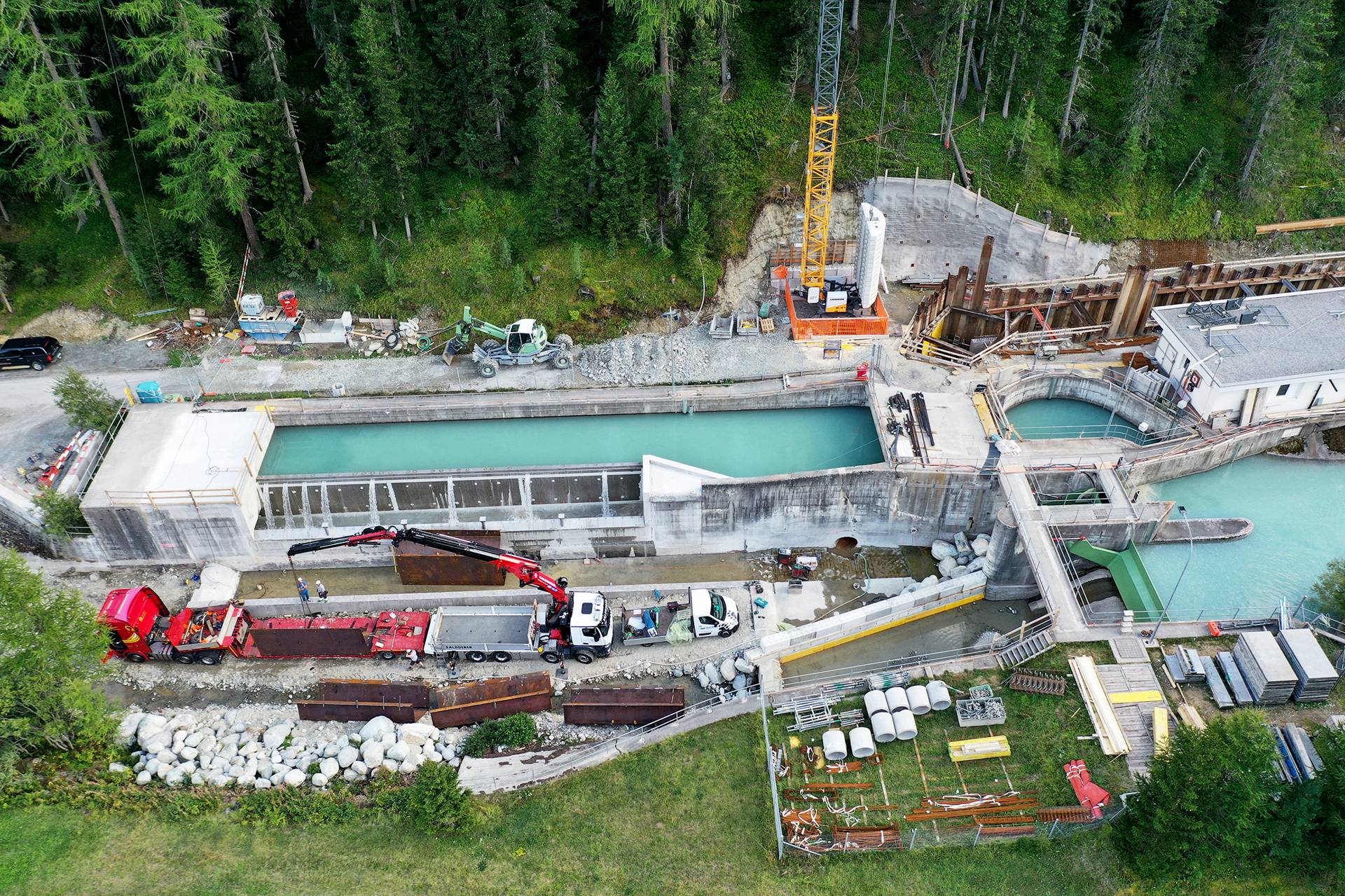Coanda technology from Tyrol impresses at a lofty height6 min read
Lesedauer: 5 MinutenWith his company Stocker Mechatronik GmbH, which Peter Stocker founded ten years ago, he has now successfully implemented a large number of hydropower projects mainly in the Alpine region.
The Tyrolean entrepreneur and engineer Peter Stocker can best be described as an “all-rounder” in the small-scale and micro-scale hydropower plant sector. Stocker, who hails from the Lechtal Alps region, is more than proud of his protective screen system with a self-cleaning effect that he has developed further himself. It was only around two months ago that the largest Coanda screen produced by the company to date was supplied for a hydropower project in the town of Oberstdorf in Upper Bavaria. The challenging installation at a height of 17 m on the outside of a boulder barrier was in fact done with aerial support from a transport helicopter.
The new diversion-type power plant at “Bacherloch” is located at the beginning of the mountain gorge of the same name in the Allgäu Alps. Not far from this location, power plant operator Christoph Ellmann runs the Einödsbach mountain restaurant. He lives there with his family at the southernmost location in the Federal Republic of Germany to be inhabited all year round. The residents in Einödsbach have been relying on hydropower generation since as far back as the 1950s. Back then, an island power plant was operated to generate electrical power to supply the community’s own needs for the first time. A connection to the public power grid of the town of Oberstdorf – which is famous as one of the venues for the “Four Hills Tournament” – has existed since 2007. With the micro power plant having been operating for around 60 years, in 2011 Christoph Ellmann, who was born in Düsseldorf, began to think about forthcoming refurbishments that would need to be made to the outdated technology: “Several different options ranging from turbine revitalisation through to a complete new construction were discussed at the time. Ultimately, the decision was made to construct a new plant with a modern cross-flow turbine. This allows a large amount of electricity to be generated and fed into the public power grid, thus generating a profit.” In addition to the machine unit, the intention was also to build a new weir and lay a penstock over a length of 45 m. From a construction point of view, the most challenging part was to design the new water catchment. As the location on the inside of an existing boulder barrier did not get approval, the steel structure was to be positioned on the opposite side on the outside of a transverse structure.
REFERENCE PLANT IMPRESSES
Christoph Ellmann became aware on the internet of the screen system adapted by Peter Stocker for his own project. During the course of the first discussion on the telephone, Stocker offered to have a look for himself at a Coanda screen in everyday use at a reference plant. This protective screen is located in the community of Boden near Tyrol’s Hahntenjoch mountain pass. As a replacement for a Tyrolean weir that was constantly blocked, it has been in use for seven years. Since it was installed, blockages have no longer been a problem, and the wedge bars made from highly durable Hardox steel also display no notable signs of wear and tear. Ellmann was also quickly won over by these benefits and awarded Stocker Mechatronik GmbH the contract to deliver the hydraulic steelwork for his new hydropower plant.
COANDA SYSTEM COMBINES MANY ADVANTAGES
When you talk to managing director Stocker, he leaves you in no doubt that right from the outset it was clear to him that it would be possible from a technical point of view to implement the water catchment on Bacherloch using his system. The fact that his company would be manufacturing the largest screen to date with a width of 11 m was of less importance to Stocker, who hails from the Lechtal Alps region. Ultimately, the individual Coanda components are assembled in a modular construction and can be adapted to any width you require. During the final installation stage, the screen modules are connected together with screw connections. One of the biggest advantages of a Coanda screen for plant operators is undoubtedly the fact that there is no need for a screen cleaner. Thanks to the shearing effect created by the design, coarse debris, branches and sediment with a particle size of more than 1 mm has no chance of getting into the penstock. The design using toughened Hardox industrial steel means that the protective screen is also able to deal with the large quantity of bedload found in an Alpine torrent with ease. Additional protection for the wedge bars which produce the Coanda effect is provided by a coarse screen positioned immediately above the fine screen with a gap width of 50 mm.
NO ORDINARY PROJECT
The most challenging part of the water catchment was definitely the installation on the outer wall of the boulder barrier at a height of roughly 17 m. This is where the second mainstay of Stocker Mechatronik GmbH’s business really paid dividends. This is because in recent years the company has also acquired an outstanding reputation in the construction of material cableways. “Thanks to our cableway projects, my fitters are used to working at great heights. In addition, we all have the necessary training and many years of experience,” explains Peter Stocker and adds: “For the installation work, we did of course make use of technical support. A walking excavator equipped with a bucket made it possible to secure a total of 12 ‘cantilever arms’ on the outer wall of the transverse structure. These cantilever arms provided an ideal support for the Coanda screen to rest on.”
INSTALLATION WITH AERIAL SUPPORT
The final installation of the Coanda screen at a lofty height at the end of March was a spectacular sight to behold. Once the screen modules had been assembled down in the valley, they were lifted up to the support structure that had been prepared by transport helicopter. There the installers fitted the screen together with screw connections and welded joints to create an 11 m wide steel trough. With aerial support it took around three hours to complete the installation. Additional operational reliability is ensured by a flush sluice gate installed at the side with a hydraulic drive that makes it possible to clean the inside of the Coanda screen of fine dirt at periodic intervals. When zek Hydro conducted an on-site inspection, the next phase of construction was beginning in mid-April with the laying of the penstock made from GRP pipes, DN 700. The penstock is connected to the Coanda screen directly by means of a flange joint and runs above ground along the concrete wall to the powerhouse located directly beneath the weir structure. The housing of the cross-flow turbine was already installed. Following its commissioning, which is scheduled for mid-May, the machine unit will deliver a maximum power output of 99 kW with an enhanced flow rate of 750 l/sec and a drop of around 17 m. Operator Ellmann reckons that he will be able to cover the electricity needs of his restaurant business with one fifth of the power that is generated and the remaining 80 % will be available to be fed into the public power grid.
Share:


